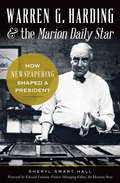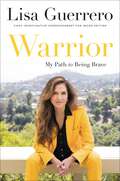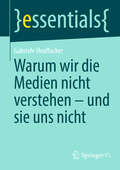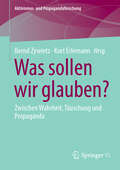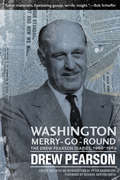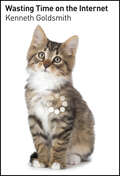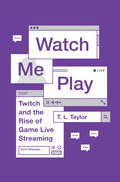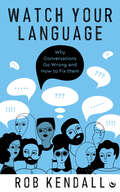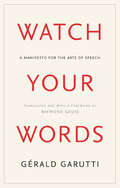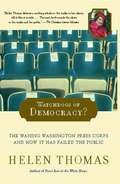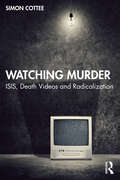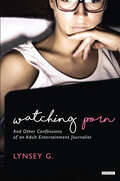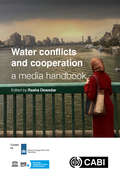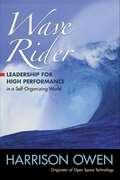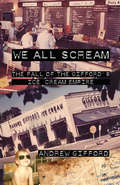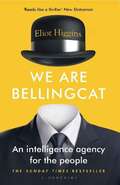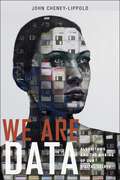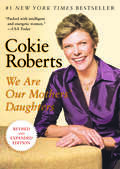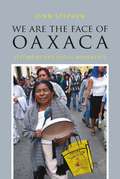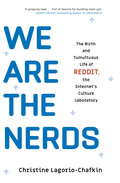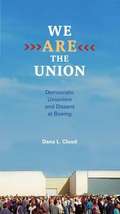- Table View
- List View
Warren G. Harding & the Marion Daily Star: How Newspapering Shaped a President
by Sheryl Smart HallHow a committed journalist transformed a small town daily newspaper—and how that editorial success inspired his policies as President of the United States. President Warren G. Harding&’s thirty-nine-year career as a newspaperman is often treated as a footnote. This book offers a unique approach to the Harding story, presenting him as he saw himself: as a newspaperman. His political successes were based on the thinking of a newspaper editor—balancing all of the facets of an issue, examining the facts and weighing the effect on the constituents. Even his approach to balancing the federal budget was built on early experience at his small, struggling newspaper, where his motto was: &“All paid in, all paid out, books even.&” The only member of the Fourth Estate to enter the White House, Harding found his voice through the pages of the Marion Daily Star. Author Sheryl Smart Hall offers an intimate view of the man, often as seen through the eyes of those who knew him best—his co-workers at the Star. Includes photos
Warriner's English Grammar and Composition Liberty Edition, First Course
by John E. WarrinerThis textbook will be a valuable aid in your study of English. In it you will find an explanation of how the language works, which is something you need to understand if you are to learn to express yourself correctly and effectively. You will find exercises and writing assignments that you need for practice. The book will teach you the difference between an effective sentence and an ineffective one, between strong writing and weak writing. You will learn to express yourself in correct, clear and interesting English.
Warring Souls: Youth, Media, and Martyrdom in Post-Revolution Iran
by Roxanne VarziWith the first Fulbright grant for research in Iran to be awarded since the Iranian revolution in 1979, Roxanne Varzi returned to the country her family left before the Iran-Iraq war. Drawing on ethnographic research she conducted in Tehran between 1991 and 2000, she provides an eloquent account of the beliefs and experiences of young, middle-class, urban Iranians. As the first generation to have come of age entirely in the period since the founding of the Islamic Republic of Iran, twenty-something Iranians comprise a vital index of the success of the nation's Islamic Revolution. Varzi describes how, since 1979, the Iranian state has attempted to produce and enforce an Islamic public sphere by governing behavior and by manipulating images--particularly images related to religious martyrdom and the bloody war with Iraq during the 1980s--through films, murals, and television shows. Yet many of the young Iranians Varzi studied quietly resist the government's conflation of religious faith and political identity. Highlighting trends that belie the government's claim that Islamic values have taken hold--including rising rates of suicide, drug use, and sex outside of marriage--Varzi argues that by concentrating on images and the performance of proper behavior, the government's campaign to produce model Islamic citizens has affected only the appearance of religious orthodoxy, and that the strictly religious public sphere is partly a mirage masking a profound crisis of faith among many Iranians. Warring Souls is a powerful account of contemporary Iran made more vivid by Varzi's inclusion of excerpts from the diaries she maintained during her research and from journal entries written by Iranian university students with whom she formed a study group.
Warrior: My Path to Being Brave
by Lisa GuerreroLisa Guerrero chronicles her iconic career—from dealing with harassment as a sports broadcaster to chasing &“bad guys&” for Inside Edition—and proves that through small, daily acts, bravery is a muscle we can strengthen over time.I&’ve been a cheerleader. A corporate executive. A Barbie Doll. A sportscaster. A soap opera vixen. A sideline reporter. A Playboy cover model. A Diamond Diva. A red-carpet correspondent. An investigative journalist. A disrupter. I made Dennis Rodman cry. I&’ve interviewed three presidents and hundreds of athletes. I costarred in a viral video that has one billion views. I sued the New England Patriots--and won. I tracked down a murderer. I was hit by a car. I butted heads with Barbara Walters. I even played myself in a movie starring Brad Pitt. During her career in sports broadcasting, Guerrero covered Super Bowls, Worlds Series, NBA Finals, and interviewed sports superstars. From the outside it seemed glamourous, but often she was miserable, told to smile more, argue less, and show a lot of leg and cleavage. Colleagues would joke—sometimes on national TV—that she clinched big interviews because of sexual acts rather than talent. She made a mistake on air during the opening game on Monday Night Football that cost her her sportscasting career... and almost her life. Fast forward a few years, and Guerrero has achieved phenomenal success as Inside Edition's Chief Investigative Correspondent. Her stories have led to arrests, changed federal legislation and policies at Fortune 500 companies, and helped shine a light on crime, scams, child abuse, and even cold case murders. And in the last decade alone, she has won over thirty-five national journalism honors and awards. Today, Guerrero is bombarded with emails and direct messages from people of every generation who all want to know the same thing: &“How are you so brave? How can I be brave too?&” Women dealing with husbands, friends, in-laws, co-workers, and bosses ask for the courage to request raises, be taken seriously at meetings, and stand up to abusive spouses. Teens and pre-teens ask for advice on dealing with bullies, teachers, and parents. Warrior—filled with the incisive stories of failure, struggles, challenges, perseverance, and finally, success—is her answer.
Warum wir die Medien nicht verstehen - und sie uns nicht (essentials)
by Gabriele HooffackerWarum berichten Medien über manche Themen und über manche nicht? Warum missfallen uns manche Nachrichten und erst recht manche Kommentare? Was führt zu Verzerrungen der Wahrnehmung beim Publikum - und auch bei Journalistinnen und Journalisten? Der Band bietet Wissenswertes aus Redaktionen und Journalismus-Ausbildung und gibt Einblicke in die Wahrnehmungspsychologie, etwa den Hostile Media Effekt oder den Third-Person- Effect. Ziel ist, fundierte Medienkritik zu ermöglichen.
Was machen Menschen und Medien?: Grundzüge einer praxistheoretischen Perspektive für Kommunikationswissenschaft und Medienforschung
by Wolfgang Reißmann Christian Pentzold Peter GentzelDie Rede von Praktiken ist in der Kommunikations- und Medienwissenschaft weit verbreitet. Eine systematische Diskussion des Potenzials praxistheoretischer Denk- und Forschungsansätze steht dagegen noch aus. Dieses Buch ist eine Einladung zur tieferen Beschäftigung mit Medienpraktiken und wirbt für eine entsprechende Neuorientierung von Kommunikationsforschung und Medienanalyse. Dazu wird der Status quo praxistheoretischer Ansätze in der Kommunikations- und Medienwissenschaft kompakt vorgestellt. Interessierte bekommen einen Einstieg und Expert:innen werden Anschlussmöglichkeiten angeboten. Es geht sowohl um Grundprinzipien praxistheoretischen Denkens als auch um die sich daraus ergebenden Haltungen sowie um Zugänge für praktische Untersuchungen. Im Zentrum stehen aktuelle Herausforderungen und die Möglichkeiten, Praktiken in Digitalmedien und vernetzten Medienumgebungen zu analysieren.
Was sollen wir glauben?: Zwischen Wahrheit, Täuschung und Propaganda (Aktivismus- und Propagandaforschung)
by Bernd Zywietz Kurt ErlemannPropaganda menschenfeindlicher Extremist*innen, grassierende Fake News, populistische Verschwörungsmythen oder ausländische Desinformationskampagnen: Die Wahrheit scheint in Gefahr, vor allem im Internet, und mit ihr die Demokratie und der öffentliche Zusammenhalt der Gesellschaft. Schließlich braucht es eine gemeinsame Faktenbasis, von der aus Konflikte gelöst, widerstreitende Interessen ausgehandelt und unterschiedliche Sichtweisen zusammengebracht werden. Dafür wird auf nachträgliche („Debunking") oder vorauseilende Aufklärung („Prebunking") gesetzt, auf die Förderung von Informationskompetenz oder das Nachprüfen bei verlässlichen Quellen angemahnt. Zwischen reinen Fakten und 'der Wahrheit' einerseits, Lüge und Täuschung andererseits gibt es jedoch viele Grauzonen. Das meint nicht nur die selten klare Trennbarkeit von Tatsachen und Meinungen: Die Beiträge des Bandes befassen sich u. a. mit dem komplizierten Verhältnis von Wahrheit und Propaganda, mit Formen und gemeinschaftsbildenden Funktionen von Unwahrheit in Sozialen Medien sowie mit textpragmatischen und rhetorischen Aspekten, die uns für Misinformationen oder Falschmeldungen anfällig machen. Doch auch dass und wie Wahrheit jenseits von Faktizität und Faktualität – so im journalistischen Erzählen oder in Gleichnissen – vermittelt wird und welche Ähnlichkeiten wie essenziellen Unterschiede sich darin gegenüber "alternativen Fakten", Desinformation und Verschwörungsmythen zeigen, ist Thema.
Washington Merry-Go-Round: The Drew Pearson Diaries, 1960-1969
by Richard Norton Smith Peter Hannaford Drew PearsonFor most of three decades, Drew Pearson was the most well-known journalist in the United States. In his daily newspaper column—the most widely syndicated in the nation—and on radio and television broadcasts, he chronicled the political and public policy news of the nation. At the same time, he worked his way into the inner circles of policy makers in the White House and Congress, lobbying for issues he believed would promote better government and world peace. Pearson, however, still found time to record his thoughts and observations in his personal diary. Published here for the first time, Washington Merry-Go-Round presents Pearson’s private impressions of life inside the Beltway from 1960 to 1969, revealing how he held the confidence of presidents—especially Lyndon B. Johnson—congressional leaders, media moguls, political insiders, and dozens of otherwise unknown sources of information. His direct interactions with the DC glitterati, including Bobby Kennedy and Douglas MacArthur, are featured throughout his diary, drawing the reader into the compelling political intrigues of 1960s Washington and providing the mysterious backstory on the famous and the notorious of the era.
Wasting Time on the Internet
by Kenneth GoldsmithUsing clear, readable prose, conceptual artist and poet Kenneth Goldsmith’s manifesto shows how our time on the internet is not really wasted but is quite productive and creative as he puts the experience in its proper theoretical and philosophical context.Kenneth Goldsmith wants you to rethink the internet. Many people feel guilty after spending hours watching cat videos or clicking link after link after link. But Goldsmith sees that “wasted” time differently. Unlike old media, the internet demands active engagement—and it’s actually making us more social, more creative, even more productive.When Goldsmith, a renowned conceptual artist and poet, introduced a class at the University of Pennsylvania called “Wasting Time on the Internet”, he nearly broke the internet. The New Yorker, the Atlantic, the Washington Post, Slate, Vice, Time, CNN, the Telegraph, and many more, ran articles expressing their shock, dismay, and, ultimately, their curiosity. Goldsmith’s ideas struck a nerve, because they are brilliantly subversive—and endlessly shareable.In Wasting Time on the Internet, Goldsmith expands upon his provocative insights, contending that our digital lives are remaking human experience. When we’re “wasting time,” we’re actually creating a culture of collaboration. We’re reading and writing more—and quite differently. And we’re turning concepts of authority and authenticity upside-down. The internet puts us in a state between deep focus and subconscious flow, a state that Goldsmith argues is ideal for creativity. Where that creativity takes us will be one of the stories of the twenty-first century.Wide-ranging, counterintuitive, engrossing, unpredictable—like the internet itself—Wasting Time on the Internet is the manifesto you didn’t know you needed.
Watch Me Play: Twitch and the Rise of Game Live Streaming (Princeton Studies in Culture and Technology #13)
by T. L. TaylorA look at the revolution in game live streaming and esports broadcastingEvery day thousands of people broadcast their gaming live to audiences over the internet using popular sites such as Twitch, which reaches more than one hundred million viewers a month. In these new platforms for interactive entertainment, big esports events featuring digital game competitors live stream globally, and audiences can interact with broadcasters—and each other—through chat in real time. What are the ramifications of this exploding online industry? Taking readers inside home studios and backstage at large esports events, Watch Me Play investigates the rise of game live streaming and how it is poised to alter how we understand media and audiences.Through extensive interviews and immersion in this gaming scene, T. L. Taylor delves into the inner workings of the live streaming platform Twitch. From branding to business practices, she shows the pleasures and work involved in this broadcasting activity, as well as the management and governance of game live streaming and its hosting communities. At a time when gaming is being reinvented through social media, the potential of an ever-growing audience is transforming user-generated content and alternative distribution methods. These changes will challenge the meaning of ownership and intellectual property and open the way to new forms of creativity.The first book to explore the online phenomenon Twitch and live streaming games, Watch Me Play offers a vibrant look at the melding of private play and public entertainment.
Watch Your Language: Why Conversations Go Wrong and How to Fix Them
by Rob KendallThe most accessible and practical book on the market about improving your personal and professional conversations, by internationally respected conversation expert Rob Kendall.Watch Your Language makes good communication easy, offering a huge range of case studies, easy-to-absorb concepts such as the Bad Place and the Tangle, and a unique "talking heads" page design that dissects examples of problematic conversations. It explains exactly why our daily conversations go wrong, how to respond when they do and provides tips on how to stop them from deteriorating in the first place. Communications expert Rob Kendall draws on over 30 years of experience to reveal:How to avoid conversations escalating into destructive argumentsHow to prepare for and conduct challenging conversationsHow to avoid defensiveness and emotional lockdownHow to read the warning signals that a conversation is going off-trackShort digestible chapters look at a wide variety of conversational scenarios, showing how to have rewarding and effective interactions with everyone in your life – from your partner, parents and children to your colleagues, boss and neighbours.
Watch Your Words: A Manifesto for the Arts of Speech
by Gerald GaruttiNever before has humanity done so much talking... But is anyone listening? For that matter, are people ever speaking to each other?We need to acknowledge that speech, as we know it, has never been so debased. We live in a world full of empty, degraded, and potentially violent speech: a daily reality that confronts us in the workplace, in the media, on the streets, on the internet and in our political lives. Verbal clashes are commonplace, while proper dialogue is rare.Gérald Garutti pushes for a return to a more constructive and responsible form of speech. He lays the groundwork for a humanistic approach: one which, contrary to the dominant culture of ignoring and humiliating others, emphasizes listening to them and mastering speech as a way of connecting. The arts of speech can contribute to the reconciliation of tensions in our society and to the realization of our full humanity.Watch Your Words is a stunning manifesto for anyone interested in how we might better communicate with each other.
Watchdogs of Democracy?
by Helen ThomasIn the course of more than sixty years spent covering Washington politics, Helen Thomas has witnessed a raft of fundamental changes in the way news is gathered and reported. Gone are the days of frequent firsthand contact with the president. Now, the press sees the president only at tightly controlled and orchestrated press conferences. In addition, Thomas sees a growing -- and alarming -- reluctance among reporters to question government spokesmen and probe for the truth. The result has been a wholesale failure by journalists to fulfill what is arguably their most vital role in contemporary American life -- to be the watchdogs of democracy. Today's journalists, according to Thomas, have become subdued, compromised lapdogs. Here, the legendary journalist and bestselling author delivers a hard-hitting manifesto on the precipitous decline in the quality and ethics of political reportage -- and issues a clarion call for change. Thomas confronts some of the most significant issues of the day, including the jailing of reporters, the conservative swing in television news coverage, and the administration's increased insistence on "managed" news. But she is most emphatic about reporters' failure to adequately question President George W. Bush and White House spokesmen about the lead-up to the invasion of Iraq, and on subjects ranging from homeland security to the economy. This, she insists, was a dire lapse. Drawing on her peerless knowledge of journalism, Washington politics, and nine presidential administrations, as well as frank interviews with leading journalists past and present, Thomas provides readers with a rich historical perspective on the roots of American journalism, the circumstances attending the rise and fall of its golden age, and the nature and consequences of its current shortcomings. The result is a powerful, eye-opening discourse on the state of political reportage -- as well as a welcome and inspiring demand for meaningful and lasting reform.
Watching Murder: ISIS, Death Videos and Radicalization
by Simon CotteeWatching Murder shines a light onto the dark world of jihadi murder videos and the people who watch and share them on the internet. Images and videos of murder, torture and other cruelties are everywhere on the internet. Why do some people seek out and watch this material, how are they affected by it and do they have a right to watch any of it in the first place? In this ground-breaking book, terrorism scholar Simon Cottee visits the murky fringes of the internet in search of answers. Focusing on ISIS, he shows how the group transformed the urban myth of the snuff movie into a grim reality watched by tens of thousands of people across the globe. On shock-sites, he finds a contingent of ISIS fans who, while hating the group, love to watch its most monstrous depredations in high definition. He interviews his fellow extremism researchers and asks them about all the dark things they have seen online and how this has affected their mental health. He speaks with the "cleaners" whose job is to report and remove violent jihadi propaganda from the internet. And he surveys thousands of young adults to find out what they think of ISIS and its notorious beheading videos. Cottee exposes the hysteria around online radicalization, and shows how our engagement with violent online spectacles is much more complex and multifaceted than many would have us believe. Watching Murder will appeal to anyone with an interest in violence, media, terrorism and ISIS. It will be of particular interest to students and scholars of terrorism studies, political science, culture and communication.
Watching Porn: And Other Confessions of an Adult Entertainment Journalist
by Lynsey G“Lynsey G. is an intrepid explorer, boldly going where few reporters have gone with such a critical eye: deep inside the real world of commercial sex.” —Tina Horn, host of the Why Are People Into That?! podcast Lynsey G. never imagined that she would ever work in porn, but at twenty-four years old, with a degree in English literature and an empty bank account, she found herself reviewing the film East Coast ASSault for an adult magazine in New York City. One interview later and it was official: she was a porn journalist. The job was supposed to be temporary—just a paycheck until she could spark her legitimate writing career—but she loved it and spent nearly a decade describing the nuances of money shots and the effectiveness of sex toys. As both a porn consumer and a porn critic, she was not quite an insider, not quite an outsider, but came to know the industry intimately.She found it so fascinating that she co-founded WHACK! Magazine. Finally, she had a platform to voice her thoughts and observations of the adult film world, as well as educate the rest of us about what really goes on behind the scenes. Eventually, Lynsey was thrust back into the “real” world, but not before realizing that one of the most diverse and nebulous—and profitable—industries on the planet isn’t so quite as different from the rest of the world as she thought. Tantalizing, eye-opening, and witty, Watching Porn is a provocative book about an average girl’s foray into the porn industry and the people who make it what it is, both in front of and behind the camera.“Marvelous.” —The New York Times Book Review
Water Conflicts and Cooperation: A Media Handbook
by Ali ThompsonThis handbook is for journalists, researchers and policy makers that are interested in working on science communication for water peace and cooperation and that are searching for ideas and inspiration. It features descriptions and reflections of the activities (action research, training modules, joint workshops, reporting grants, podcast, online photo campaign...) implemented by Open Water Diplomacy project in the Nile basin, and in the new international basins identified under the top-up activities on capacity development, as well as activities in the field of media and water diplomacy implemented by other actors. It will be an online open access repository of case studies and best practices in the field of journalism and science communication for water peace and cooperation.
Wave Rider: Leadership for High Performance
by Harrison OwenWave Rider is about leveraging the power of self-organization for high performance in all sizes and types of organizations.
Waveform Analysis of Sound
by Mikio TohyamaWhat is this sound? What does that sound indicate? These are two questions frequently heard in daily conversation. Sound results from the vibrations of elastic media and in daily life provides informative signals of events happening in the surrounding environment. In interpreting auditory sensations, the human ear seems particularly good at extracting the signal signatures from sound waves. Although exploring auditory processing schemes may be beyond our capabilities, source signature analysis is a very attractive area in which signal-processing schemes can be developed using mathematical expressions. This book is inspired by such processing schemes and is oriented to signature analysis of waveforms. Most of the examples in the book are taken from data of sound and vibrations; however, the methods and theories are mostly formulated using mathematical expressions rather than by acoustical interpretation. This book might therefore be attractive and informative for scientists, engineers, researchers, and graduate students who are interested in the mathematical representation of signals and the applications of Fourier analysis. The book can be described as being practically self-contained but does assume readers are familiar with introductory topics in discrete signal processing, as in the discrete Fourier transform. Hence this book might be also usable as a textbook in graduate courses in applied mathematics on topics such as complex functions. Almost all scientific phenomena are sensed as waves propagating in some space. Over the years, waveform analysis has therefore been one of the resilient academic areas of study and still is seen as fertile ground for development. In particular, waveform analysis based on the theory of linear systems would be a good example where a physical interpretation can be given to the mathematical theory of complex functions in terms of magnitude, angle, poles, and zeros of complex functions. For readers who are interested in the physical aspects of sound and vibration data or elementary formulation of wave equations and their solutions, the book Sound and Signals by M. Tohyama (Springer 2011) is recommended. It can serve as a complementary companion to this present volume or independently as a good reference.
We All Scream: The Fall of the Gifford's Ice Cream Empire
by Andrew GiffordFor more than 70 years, Gifford's Ice Cream and Candy Company was associated with nothing but pleasure for native Washingtonians and visitors to the nation's capital. Few knew the dark truth... Behind the iconic business's happy facade lay elaborate schemes, a crushing bankruptcy, two million dollars of missing cash, and a tragic suicide. As the last Gifford heir unfolds his story with remarkable immediacy and candor, he reveals the byzantine betrayals and intrigue rooted in the company from its modest beginnings—dark influences that would ultimately destroy the legendary Gifford business and its troubled founding family.
We Are Bellingcat: Global Crime, Online Sleuths, and the Bold Future of News
by Eliot HigginsTHE SUNDAY TIMES BESTSELLER <p><p> 'John le Carré demystified the intelligence services; Higgins has demystified intelligence gathering itself' Financial Times <p><p> 'Uplifting . . . Riveting . . . What will fire people through these pages, gripped, is the focused, and extraordinary investigations that Bellingcat runs . . . Each runs as if the concluding chapter of a Holmesian whodunit' Telegraph <p><p> 'We Are Bellingcat is Higgins's gripping account of how he reinvented reporting for the internet age . . . A manifesto for optimism in a dark age' Luke Harding, Observer <p><p> How did a collective of self-taught internet sleuths end up solving some of the biggest crimes of our time? <p><p> Bellingcat, the home-grown investigative unit, is redefining the way we think about news, politics and the digital future. Here, their founder - a high-school dropout on a kitchen laptop - tells the story of how they created a whole new category of information-gathering, galvanising citizen journalists across the globe to expose war crimes and pick apart disinformation, using just their computers. <p><p> From the downing of Malaysia Flight 17 over the Ukraine to the sourcing of weapons in the Syrian Civil War and the identification of the Salisbury poisoners, We Are Bellingcat digs deep into some of Bellingcat's most successful investigations. It explores the most cutting-edge tools for analysing data, from virtual-reality software that can build photorealistic 3D models of a crime scene, to apps that can identify exactly what time of day a photograph was taken. <p><p> In our age of uncertain truths, Bellingcat is what the world needs right now - an intelligence agency by the people, for the people.
We Are Data: Algorithms and the Making of Our Digital Selves
by John Cheney-LippoldWhat identity means in an algorithmic age: how it works, how our lives are controlled by it, and how we can resist itAlgorithms are everywhere, organizing the near limitless data that exists in our world. Derived from our every search, like, click, and purchase, algorithms determine the news we get, the ads we see, the information accessible to us and even who our friends are. These complex configurations not only form knowledge and social relationships in the digital and physical world, but also determine who we are and who we can be, both on and offline. Algorithms create and recreate us, using our data to assign and reassign our gender, race, sexuality, and citizenship status. They can recognize us as celebrities or mark us as terrorists. In this era of ubiquitous surveillance, contemporary data collection entails more than gathering information about us. Entities like Google, Facebook, and the NSA also decide what that information means, constructing our worlds and the identities we inhabit in the process. We have little control over who we algorithmically are. Our identities are made useful not for us—but for someone else. Through a series of entertaining and engaging examples, John Cheney-Lippold draws on the social constructions of identity to advance a new understanding of our algorithmic identities. We Are Data will educate and inspire readers who want to wrest back some freedom in our increasingly surveilled and algorithmically-constructed world.
We Are Our Mothers' Daughters: Revised And Expanded Edition
by Cokie RobertsThe “entertaining and evocative” #1 New York Times bestseller, profiling extraordinary women from mother to mechanic and sister to soldier (The Hill).This is a revised and expanded edition of legendary journalist Cokie Roberts’s collection of personal essays and biographical profiles, “a celebration of women in their various roles: mother, sister, civil rights advocate, consumer advocate, first-class mechanic, politician—which Roberts’ own mother once was” (The Washington Post).“A flock of fascinating women.” —Dallas Morning News“Inspirational stories of women who have successfully nurtured their children while working outside the home. With humor, honesty, and optimism, [Roberts] provides perspective on this balancing act.” —Newsday“Her subject matter intrigues for both her personal spin and the biographies of unusual and powerful women.” —Los Angeles Times“Lively reading.” —USA Today
We Are the Face of Oaxaca: Testimony and Social Movements
by Lynn StephenA massive uprising against the Mexican state of Oaxaca began with the emergence of the Popular Assembly of the Peoples of Oaxaca (APPO) in June 2006. A coalition of more than 300 organizations, APPO disrupted the functions of Oaxaca's government for six months. It began to develop an inclusive and participatory political vision for the state. Testimonials were broadcast on radio and television stations appropriated by APPO, shared at public demonstrations, debated in homes and in the streets, and disseminated around the world via the Internet. The movement was met with violent repression. Participants were imprisoned, tortured, and even killed. Lynn Stephen emphasizes the crucial role of testimony in human rights work, indigenous cultural history, community and indigenous radio, and women's articulation of their rights to speak and be heard. She also explores transborder support for APPO, particularly among Oaxacan immigrants in Los Angeles. The book is supplemented by a website featuring video testimonials, pictures, documents, and a timeline of key events.
We Are the Nerds: The Birth and Tumultuous Life of REDDIT, the Internet's Culture Laboratory
by Christine Lagorio-Chafkin'A gripping read' Adam Grant, bestselling author of OriginalsReddit hails itself as 'the front page of the Internet'. It's the sixth most-visited website in the world - and yet, millions have no idea what it is. They should be paying attention.This definitive account of the birth and life of Reddit is perfect for readers of The Everything Store, Googled and The Facebook Effect.We Are the Nerds takes readers inside this captivating, maddening enterprise, whose army of obsessed users have been credited with everything from solving crimes and spurring millions in charitable donations to seeding alt-right fury and even landing Donald Trump in the White House. Reddit has become a mirror of the Internet itself: It has dark trenches, shiny memes, malicious trolls, and a heart-warming ability to connect people across cultures, oceans, and ideological divides.This is the gripping story of how Reddit's founders, Steve Huffman and Alexis Ohanian, transformed themselves from student video-gamers into Silicon Valley millionaires as they turned their creation into an icon of the digital age. But the journey was often fraught. Reporting on Reddit for more than six years, conducting hundreds of interviews and gaining exclusive access to its founders, Christine Lagorio-Chafkin has written the definitive account of the birth and life of Reddit. Packed with revelatory details about its biggest triumphs and controversies, this inside look at Reddit includes fresh insights on the relationship between Huffman and Ohanian, staff turmoil, the tragic life of Aaron Swartz, and Reddit's struggle to become profitable.In a time when we are increasingly concerned about privacy and manipulation on social platforms, We Are the Nerds reveals Reddit's central role in the dissemination of culture and information in history's first fully digital century. Rigorously reported and highly entertaining, We Are the Nerds explores how this unique platform has changed the way we all communicate today.PRAISE FOR THE BOOK:'Incisive, witty and brilliantly written' - Emily Chang, bestselling author of Brotopia'A triumph - a business book that reads like a page-turning novel' - James Ledbetter, author of One Nation Under Gold'The best, grittiest, most accurate book yet about what it's like to build a startup and a community from scratch' - John Zeratsky, bestselling author of Sprint and Make Time'A gripping, entertaining book that is a must-read for every entrepreneur' - Daymond John, bestselling author of Rise and Grind'Too many books on tech feel like they have been Googled together; Lagorio-Chafkin's is rich in original reportage' - TLS
We Are the Union: Democratic Unionism and Dissent at Boeing
by Dana L. CloudIn this extraordinary tale of union democracy, Dana L. Cloud engages union reformers at Boeing in Wichita and Seattle to reveal how ordinary workers attempted to take command of their futures by chipping away at the cozy partnership between union leadership and corporate management. Taking readers into the central dilemma of having to fight an institution while simultaneously using it as a bastion of basic self-defense, We Are the Union offers a sophisticated exploration of the structural opportunities and balance of forces at play in modern unions told through a highly relevant case study. Focusing on the 1995 strike at Boeing, Cloud renders a multi-layered account of the battles between company and the union and within the union led by Unionists for Democratic Change and two other dissident groups. She gives voice to the company's claims of the hardships of competitiveness and the entrenched union leaders' calls for concessions in the name of job security, alongside the democratic union reformers' fight for a rank-and-file upsurge against both the company and the union leaders. We Are the Union is grounded in on-site research and interviews and focuses on the efforts by Unionists for Democratic Change to reform unions from within. Incorporating theory and methods from the fields of organizational communication as well as labor studies, Cloud methodically uncovers and analyzes the goals, strategies, and dilemmas of the dissidents who, while wanting to uphold the ideas and ideals of the union, took up the gauntlet to make it more responsive to workers and less conciliatory toward management, especially in times of economic stress or crisis. Cloud calls for a revival of militant unionism as a response to union leaders' embracing of management and training programs that put workers in the same camp as management, arguing that reform groups should look to the emergence of powerful industrial unions in the United States for guidance on revolutionizing existing institutions and building new ones that truly accommodate workers' needs. Drawing from communication studies, labor history, and oral history and including a chapter co-written with Boeing worker Keith Thomas, We Are the Union contextualizes what happened at Boeing as an exemplar of agency that speaks both to the past and the future.
